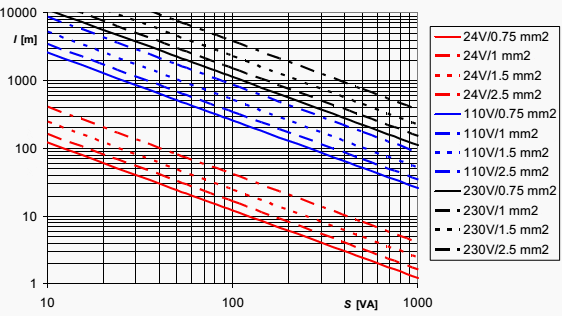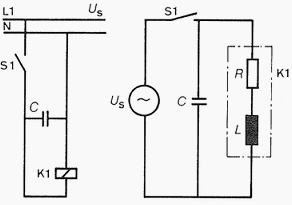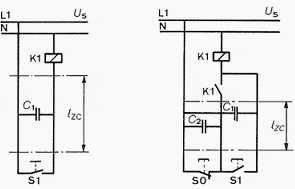
Switching contactor and effect of long control lines
Voltage drop
In accordance with IEC 60947-4-1 and IEC 60947-5-1, the normal control voltage range of power and control contactors lies between 85 … 110 % of the rated control voltage. Within these limits contactors pull-in perfectly.
Frequently contactors are offered with an extended control voltage range, thus for example with contactors with electronic coil control. The technical documentation of the devices used is definitive.
At small control voltages and with long control lines, the voltage drop across the lines to the contactor (both out-going and return conductors should be considered!) can be so big that pulling-in reliably is no longer guaranteed. In addition to burnt coils, another consequence of this may be welding of the main contacts.
It must therefore be ensured that taking into account:
- Supply voltage variations
- Voltage drop at the control transformer at peak load and
- Voltage drop across the control lines the minimum pull-in voltage is always guaranteed.
For the voltage drop across the control lines the following applies approximately:

or for the maximum line length at a given permissible voltage drop:

- l – Line length (supply and return line) [m]
- lmax - maximum line length (feeding and return line) [m]
- uR - Percentage voltage drop [%]
- UC – Rated control voltage [V]
- S – Pickup power of the contactor [VA] κ Conductivity of the conductor material [m·Ω-1·mm-1] = 57 for copper
- A – Conductor cross section [mm2]

Figure 1 - Line lengths for a voltage drop of 5 % and copper conductors
l – Line length (feeding and return line)
S – Apparent power of load
S – Apparent power of load
Effect of the cable capacitance
With AC controls with long control lines, low coil power ratings of the contactors and high control voltage, depending on the topography of the circuit, the capacitance of the control line can be in parallel to the controlling contact and practically bypass it when it is open.
This can mean that when the control contact has opened sufficient current continues to flow via the cable capacitance causing the contactor not to drop out. An example may be a contactor that is controlled by a distantly located sensor (for example limit-switch).

Figure 2 - When the control contact switches off the cable to the contactor, the capacitance of the line causes at most a slight drop-off delay.

Figure 3 - If the long control line to the contactor stays live when the control contact is open, the current via the cable capacitance can prevent the contactor from dropping out. With pulse contact control, the capacitance of the lines acts twice, whereby the permissible line length is halved.
A worked example would be:
IH = 0.25 ICN
UH = 0.6 UC
cos φ = 0.3
UH = 0.6 UC
cos φ = 0.3
IH – Holding current of the contactor
ICN – Rated current the contactor coil
UH – Drop-out voltage of the contactor
UC – Control voltage
cos φ – Power factor of the contactor coil (on-state)
ICN – Rated current the contactor coil
UH – Drop-out voltage of the contactor
UC – Control voltage
cos φ – Power factor of the contactor coil (on-state)
The permissible cable capacitance is calculated at 50 Hz approximately to be:
CZ ≈ 500 · SH/UC2 [μF]
CZ - Permissible cable capacitance [μF]
SH – Holding power at UC[VA]
UC – Control voltage [V]
SH – Holding power at UC[VA]
UC – Control voltage [V]
At a typical cable capacitance of 0.3 μF/km the permissible line length for maintained contact control is:

With momentary contact control the line length is halved. Graphic presentation for the control voltages 110 V and 230 V see Figure 4. As the cable capacitance is very much dependent on the type of cable, it is recommended in case of doubt to obtain the specific value from the manufacturer or to measure it.

Figure 4 - Permissible line length in accordance with the above conditions for maintained contact control at control voltages of 110 V and 230 V at 50 Hz
l – Line length
S – Apparent power (holding power) of the contactor
S – Apparent power (holding power) of the contactor
If there are problem with respect to the permissible line length because of the line capacitance the following measures are possible in accordance with above discussion:
- Application of an additional load (resistor parallel to contactor coil)
- Use of a larger contactor with bigger holding power
- Use of a lower control voltage
- Use of direct voltage
Reference: Allen Bradley Low Voltage Switchgear and Controlgear // Rockwell Automation
EEP recommends
TAGS
cable, cable capacitance, capacitance, contactor, control lines, control voltage, power, voltage drop
FILLED UNDER CATEGORY
Energy and Power Low Voltage
FOR YOUR PHILIPPINE ELECTRICAL CONCERNS...NEEDS...INSTALLATION...QUOTATION...ORDERS
KINDLY EMAIL US: SAFEELECTRICAL2013@GMAIL.COM
FOR YOUR PHILIPPINE ELECTRICAL CONCERNS...NEEDS...INSTALLATION...QUOTATION...ORDERS:
KINDLY EMAIL US: SAFEELECTRICAL2013@GMAIL.COM





No comments:
Post a Comment